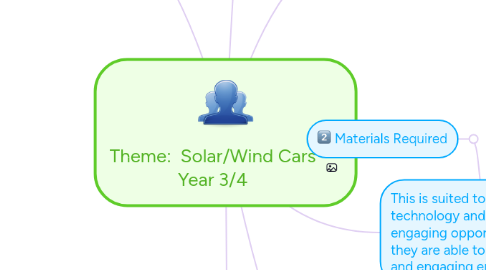
1. Lesson steps:
1.1. Introduction (10 Minutes) 1. The teacher will begin the lesson by asking for the students to sit down and get their Technology books out. 2. From here, the teacher will turn on the Interactive Whiteboard (IWB) and instruct the students to conduct a Think-Pair-Share about what people can design and produce and why they would do this. 3. The teacher will then take the students through the PowerPoint about technology, brainstorming ideas about why and how things can be produced. The teacher will also extend students’ knowledge of technology by explaining that it takes a long time and a lot of resources to develop these things. This will be illustrated with a video of the production of a car. 4. The teacher will then explain that they are going to be forming groups of 3 or 4 and identifying materials and resources needed to develop certain objects, and matching these to images of the objects themselves. The teacher will then form the groups using the pop-stick method. (Image Appendix 1, 2 attached)
1.2. Body (40 minutes) 1. From here, the teacher will have a student hand out the worksheets and materials to each group. The teacher will have a copy of the worksheet on the IWB. 2. The teacher will then explain to the students that they are going to be matching the images of the produced items to the tools and materials needed to create these. 3. This will be demonstrated by the teacher. 4. The teacher will also explain that the students will have to write down their answers on their worksheet about why they think the specific tools and resources are needed, as well as why the product needs to be produced. 5. The teacher will then allow the students to begin working. (Image 3) 6. The teacher will walk around the room, monitoring and questioning the students as they work. 7. At the conclusion of the working time, the teacher will ask for the students to return to the mat and sit down. (Image 4)
1.3. Conclusion (10 minutes) Once the students are paying attention, the teacher will ask for the students to discuss what you need to produce some of the products, and why this is so. This will be shared in a group discussion. 2. From here, the teacher will select students to share their answers with the class. 3. Following this, the teacher will collect the students work and conclude the lesson.
2. Learning and teaching alternatives:
2.1. Teaching adjustments regarding this lesson could include extending the task so the more advanced students can think of different ways we can design or make something more efficient, while for the weaker students I could scaffold and assist more, while also offering easier examples to allow for them to grasp the concept more thoroughly. Teaching adjustments could include offering alternatives for the different learning styles of students. As well as this, students could be allowed to draw their ideas or interpretations down rather than writing if they are not linguistic earners
2.2. Idea 2
2.3. Idea 3
3. Focus questions: Why do we design products? What do we need to design these? How long do you think it takes to design these things? What kind of equipment do you think the people need to use to produce it? What have we talked about today? What have we learnt about?
3.1. Assessment will be regarding Effectively identify opportunities for designing new products through discussion and visual information. • Write about why specific tools and equipment is needed to produce a product, as well as why the product is needed. Use interaction skills, including active listening behaviours and effectively communicate ideas in a group. This will occur through
4. Links to Australian curriculum
4.1. This aligns to the Design and Technologies Processes and Skills Curriculum outcome of: Critique needs or opportunities for designing and explore and test a variety of materials, components, tools and equipment and the techniques needed to produce designed solutions.
4.1.1. Cross Curricular Links: This theme has cross-curricular links to English speaking and listening skills, as well as viewing.
4.1.2. Specific Learning Focus: At the conclusion of this learning experience each student should be able to: • Effectively identify opportunities for designing new products through discussion and visual information. • Write about why specific tools and equipment is needed to produce a product, as well as why the product is needed. Use interaction skills, including active listening behaviours and effectively communicate ideas in a group.
4.1.3. Cross-curricular Priorities: This links to the cross-curricular priority of Sustainability through having the students investigate and design a sustainably fuelled product. Designing action for sustainability requires an evaluation of past practices, the assessment of scientific and technological developments, and balanced judgments based on projected future economic, social and environmental impacts. This shows the suitability for these students to have the link to sustainability as this educates them about how to be sustainable and what sustainabiolity is, as well as provides insight and opportunity for further cross-curricular links to S&E and Sceince through links to the environment.
